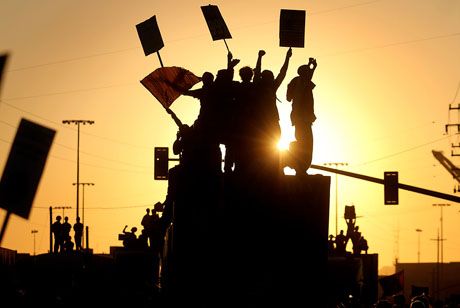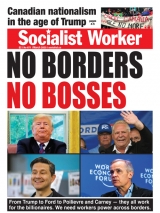Columns
You are here
Divide and rule: Aboriginal peoples and the Constitution

November 20, 2011
The debates surrounding the Constitution, the highest law of the land in a capitalist state, have largely been about the continued exclusion of Quebec. But Aboriginal peoples have also been a target, often played off against the Québécois in a chauvinistic game of divide and rule.
As Quebec and Aboriginal rights were counterposed, the far right advanced, ultimately taking the form of the Reform Party – the predecessor of Stephen Harper’s wing of the federal Tories. A brief chronology of the decade following the Meech Lake Accord indicates how this process unfolded.
April 1987: The Meech Lake Accord, recognizing Quebec as a distinct society, was drafted and adopted at a Constitutional conference of premiers and the federal Tories led by Brian Mulroney. The deadline was set for June 1990, by which date all provinces agreed to ratify the amendment.
December 1988: The Supreme Court of Canada struck down the French-only signs section of Bill 101, the Quebec language law. Following this decision, Quebec Liberal Premier Robert Bourassa invoked the “notwithstanding clause” of the Canadian Constitution. This clause allows provinces to suspend application of the Canadian Charter of Rights and Freedoms in certain circumstances.
The Supreme Court decision was so clearly a denial of basic democratic rights that even this federalist government was compelled to reject it to maintain political support in Quebec.
June 1990: The Meech Lake Accord failed. Clyde Wells, Premier of Newfoundland, withdrew that province’s support. Then Manitoba NDP MLA and Aboriginal spokesperson Elijah Harper challenged the accord 12 days before final deadline. Gary Filmon, Tory minority government Premier of Manitoba, and Liberal leader Sharon Carstairs, who held the balance of power, watched gleefully as the province withdrew support for Meech Lake.
Upon the defeat of the Meech Lake Accord, Lucien Bouchard quit Mulroney’s Tory government and announced plans to form a new federal party that will fight for Quebec rights (Bloc Québécois). Elijah Harper later would cross the floor and join the Liberal Party.
July 1990: The Oka uprising began. The Mohawk warriors defended ancestral land against plans to build a golf course. One Quebec police officer was killed. The federal army fully mobilized to support the Securité du Québec (SQ) police repression, adding 2,629 troops, 874 jeeps, 270 armoured personnel carriers and 12 helicopters. After 77 days, the stand off ended in mass arrests.
The English language media presented these events as if it was a conflict of Quebec people against Mohawk rights. There are no grounds for this analysis. In fact there was more active support for the Oka Mohawks in Montreal than in any other city in Canada. Also, the charges against 14 Mohawk leaders came to trial, where the majority were acquitted by a Québécois jury on grounds that Canadian law did not apply to Aboriginal peoples.
August 1992: Another constitutional amendment, the Charlottetown Accord, was agreed by all premiers and the federal government. It included recognition of Quebec as a distinct society, as well as recognition of inherent Aboriginal land rights. The date for a federal referendum was set to coincide with Quebec’s proposed date for a provincial referendum.
October 1992: The Charlottetown Accord was defeated in a federal referendum. The Assembly of First Nations and the Inuit Tapirisat had endorsed the Accord.
October 1993: A federal election saw a Liberal majority government with Jean Chrétien as Prime Minister. The Tories declined to two seats. The Reform Party ran in the federal election, led by Preston Manning. With 52 seats, Reform came just two seats shy of forming the Official Opposition, but gained only one seat in Ontario. The Official Opposition went to the Bloc Québécois, led by Lucien Bouchard, which gained 54 seats.
Summer 1995: Twenty-four Aboriginal activists and four supporters occupied sacred land in the name of the Shuswap Nation, at Gustafsen Lake in BC. BC’s NDP government called in the RCMP in the largest paramilitary mobilization in Canadian history. All communication was cut off, food supplies stopped, and people were prevented at gunpoint from leaving or entering the camp. After a negotiated retreat, the trial of the Gustafsen defenders was initiated.
September 1995: Twenty unarmed members of the Stoney Point band occupied ancestral land that was legally theirs at Ipperwash Provincial Park, near Sarnia, Ontario. Two hundred Ontario Provincial Police were sent in on the order of Ontario Tory Premier, Mike Harris, and opened fire. The OPP fatally wounded one activist, Dudley George.
October 1995: The Cree of northern Quebec held a separate referendum. Cree voters were asked: “Do you consent, as a people, that the Government of Quebec separate the James Bay Crees and Cree traditional territory from Canada in the event of a Yes vote in the Quebec referendum?” The Cree voted 96.3 per cent to stay with Canada.
October 1995: In the Quebec referendum, a 50.6 per cent majority voted against sovereignty association.
January 1996: In a federal government cabinet shuffle, Stéphane Dion is brought into the Liberal Cabinet as Intergovernmental Affairs minister. The Liberals advance a strategy for Quebec that mimics the Reform Party. It includes a plan that, in the event of a third referendum, Canada could be ruled by military partition. In this scenario, the Cree of Quebec are to be partitioned by the federal state in the name of “protection.”
The divide-and-rule tactics of the federal state clearly demand a response – a unified movement that supports the rights of all the oppressed to self-determination.
Section:
- Log in to post comments










